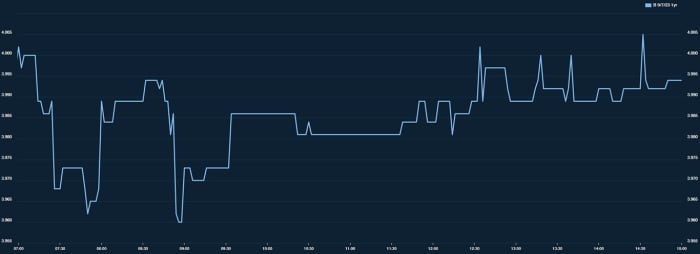The yield on the 1-year Treasury note is testing 4%, a level that traders say could spill over into other rates and send shivers through financial markets, as the Federal Reserve presses forward in earnest with its campaign to shrink its $8.8 trillion balance sheet.
That balance-sheet process, known as “quantitative tightening,” is intended to complement the central bank’s series of aggressive rate hikes, one of which is expected to arrive next Wednesday. The Fed “is now tightening on all cylinders” as the ”training wheels” come off QT following a slow start, according to BofA Securities rates strategist Mark Cabana. And traders say that’s one of the reasons behind the one-year yield’s moves on Thursday, which included intermittently touching or going slightly above 4% before retreating again.
“Four percent is a magic number and one that frightens a lot of asset markets, including equity markets, and basically everyone,” said head trader John Farawell with Roosevelt & Cross, a bond underwriter in New York. The Fed’s QT process is one of the reasons this is happening and “is adding to pressure on the front end of the curve.”
A 4% yield is likely to spill over into other rates in the Treasurys market as expectations solidify around aggressive rate moves from the Fed, Farawell said via phone Thursday. “You may see more of the same as what you are seeing now — more stress on the equity market — and you may see equity people getting out.”
Read: Stock-market wild card: What investors need to know as Fed shrinks balance sheet at faster pace
Indeed, all three major U.S. indexes
DJIA,
COMP,
finished lower on Thursday as Treasury yields continued to climb.
Data provided by Tradeweb shows that the one-year rate
TMUBMUSD01Y,
went slightly above 4% three times during the New York morning and afternoon, before retreating.

Source: Tradeweb
The one-year yield, which reflects expectations around the Fed’s near-term policy path, hasn’t ended the New York trading session above 4% since Oct. 31, 2007, according to FactSet.
Meanwhile, the bond market flashed more worrisome signals about the outlook: The spread between the 2- and 10-year Treasury rates fell to minus 41.3 basis points, while the gap between 5- and 30-year rates shrank to minus 19.3 basis points.
Financial market participants have been slowly coming around to the view that the Federal Reserve will keep tightening financial conditions until something breaks in the U.S. economy, in order to bring down the hottest inflation period of the past four decades.
Besides QT, other reasons for the one-year yield’s move toward 4% is that traders are increasingly focused on the level at which policy makers will end rate increases, known as the terminal rate, and there’s anxiety over the chance that one of the next moves by the Fed could be a jumbo-size 100-basis-point hike, according to one strategist.
Higher rates, particularly in the one-year Treasury, benefit investors who haven’t yet had a chance to get into the fixed-income market, giving them a chance to grab higher yields at a lower price. “We could see investors going to the safety of Treasurys and may see more players come into the bond market. Treasurys could become a viable option for some people,” Farawell of Roosevelt & Cross told MarketWatch. He noted that the rate on the 1-year Treasury has been “fractional,” or almost zero, between 2020 and early this year.
When policy makers were flooding markets with liquidity during the era of easy money, through the process known as quantitative easing, stocks were seen as one of the biggest beneficiaries. So it’s only logical that the opposite process — quantitative tightening — and accelerating it could hit equities further.
This month, the maximum pace of the Fed’s balance-sheet reduction rose to $95 billion a month in Treasurys and mortgage-backed securities, up from $47.5 billion a month previously. That increasing pace of QT will put more Treasurys and mortgage-backed securities in private hands, create aggressive competition among commercial banks for funding, and lead to higher borrowing costs, according to BofA’s Cabana.
QT’s impact to date “has been minimal,” Cabana wrote in a note Thursday. Over time, though, this should ultimately result in “higher funding rates, tighter financial conditions, and risk asset headwinds.”
See: The next financial crisis may already be brewing — but not where investors might expect
Still, there was a sense among traders that the Fed’s accelerating pace of QT is already having an impact.
“There’s a psychological impact of hitting 4% on the 1-year yield — which has the potential to spill into other capital markets abroad,” said Larry Milstein, senior managing director of government debt trading at R.W. Pressprich & Co. in New York. “People now realize the Fed is going to have to stay higher for long, inflation is not coming down as quickly as expected, and the terminal rate is going up.”
“For a long period of time, people had been talking about TINA, but you don’t necessarily have to be in the equity market to get a return,” Milstein said via phone. TINA is an acronym used by traders for the idea that “there is no alternative” to stocks.
Like Farawell, Milstein sees more investors pulling money out of equities and putting it into shorter-term Treasurys.
Source: https://www.marketwatch.com/story/one-year-treasury-yield-is-flirting-with-magic-4-level-as-fed-tightens-on-all-cylinders-11663265445?siteid=yhoof2&yptr=yahoo
